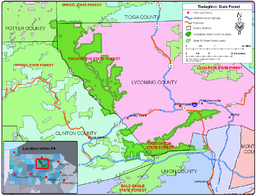Tiadaghton State Forest
| Tiadaghton State Forest | |
| Pennsylvania State Forest | |
|
Tiadaghton State Forest: White Deer Hole Creek near the Fourth Gap of South White Deer Ridge, Washington Township, Lycoming County, Pennsylvania
|
|
| Named for: Tiadaghton, an Iroquois name for Pine Creek | |
| Country | United States |
|---|---|
| State | Pennsylvania |
| Counties | Clinton, Lycoming, Potter, Tioga, Union |
| Elevation | 1,493 ft (455.1 m) |
| Coordinates | 41°09′40″N 77°02′21″W / 41.16111°N 77.03917°WCoordinates: 41°09′40″N 77°02′21″W / 41.16111°N 77.03917°W |
| Area | 215,500 acres (87,210 ha) |
| IUCN category | Managed Resource Protected Area (IUCN VI) |
|
Tiadaghton State Forest
|
|
| Website: Tiadaghton State Forest | |
Tiadaghton State Forest is a Pennsylvania State Forest in the Pennsylvania Bureau of Forestry District #12. The forest is chiefly in western and southern Lycoming County, with small portions in Clinton, Potter, Tioga, and Union Counties.
As of July 1, 2005 the state forest lands in eastern Lycoming County, which had been part of Tiadaghton State Forest, became part of the new Loyalsock State Forest. The main office for district #12 is in South Williamsport, in Lycoming County, Pennsylvania in the United States. There are plans to move it to the Pine Creek valley, perhaps to the village of Waterville. Tiadaghton is the Iroquois name for Pine Creek, but its meaning is unknown.
As the timber was exhausted and the land burned, many companies simply abandoned their holdings. Conservationists like Dr. Joseph Rothrock became concerned that the forests would not regrow if they were not managed properly. They called for the state to purchase land from the lumber companies and for a change in the philosophy of forest management. In 1895 Rothrock was appointed the first commissioner of the Pennsylvania Department of Forests and Waters, the forerunner of today's Department of Conservation and Natural Resources. In 1897 the Pennsylvania General Assembly passed legislation which authorized the purchase of "unseated lands for forest reservations" and the first Pennsylvania state forest lands were acquired the following year.
...
Wikipedia



